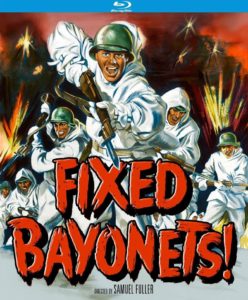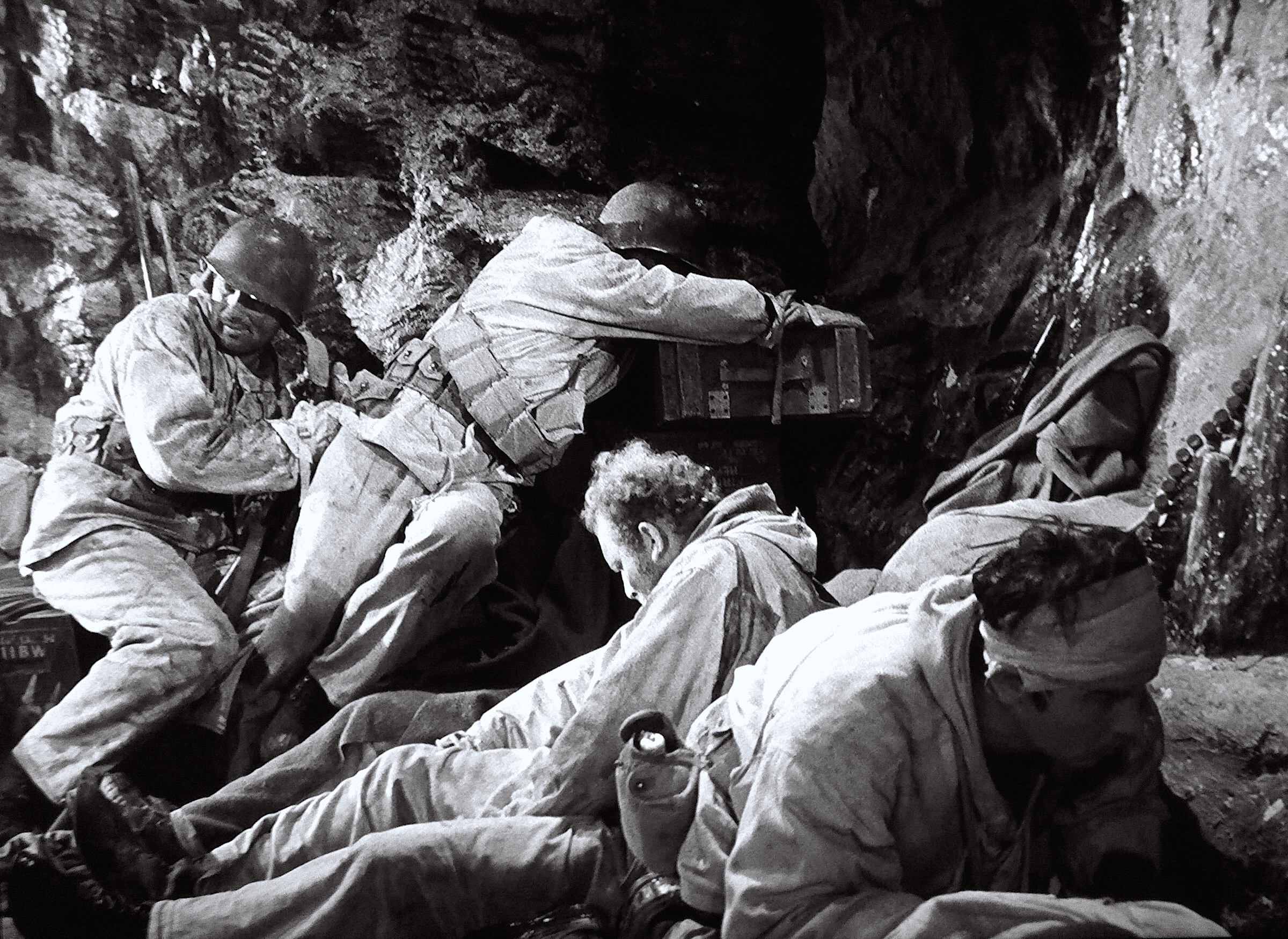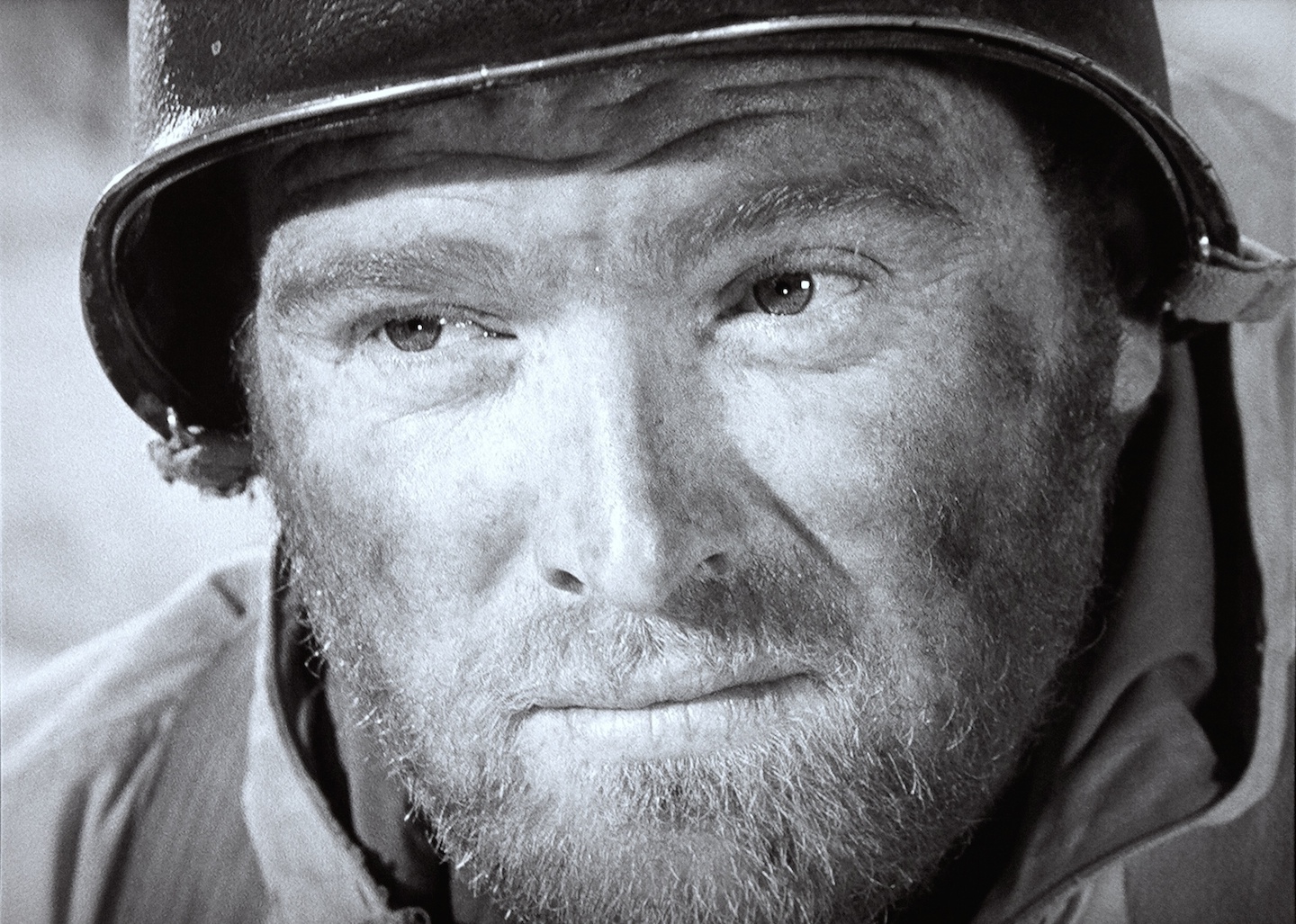Fuller Puts Soldiers Through The Grinder In Korean War Actioner
DIRECTED BY SAMUEL FULLER/1951
STREET DATE: SEPTEMBER 20, 2016/KINO LORBER
 One tightly-bundled and scruffy, rifle-toting soldier approaches another, surrounded high by North Korean snow, and the two trade purple street prose straight out of a ’40s dime novel. The tinny patter (“What’re you beefin’ at, you’re gettin’ experience, ain’t ya?”) somehow fits perfectly with the obvious studio sets and the company of stick-figure types that fill out the rest of the cast. It’s all a bit like watching the final film project of the most precocious high schooler in your class, and it marches dangerously close to laughably stilted, even by 1951 standards. But before long, and quite against the will, you get caught in the swelling and ebbing tension of hard-bitten director Sam Fuller’s rhythm, and eventually connect with his guileless treatment of the men trapped in this iteration of wartime hell. Soon the life and death of characters take on a meaning and depth that transcend the seemingly non-existent budget.
One tightly-bundled and scruffy, rifle-toting soldier approaches another, surrounded high by North Korean snow, and the two trade purple street prose straight out of a ’40s dime novel. The tinny patter (“What’re you beefin’ at, you’re gettin’ experience, ain’t ya?”) somehow fits perfectly with the obvious studio sets and the company of stick-figure types that fill out the rest of the cast. It’s all a bit like watching the final film project of the most precocious high schooler in your class, and it marches dangerously close to laughably stilted, even by 1951 standards. But before long, and quite against the will, you get caught in the swelling and ebbing tension of hard-bitten director Sam Fuller’s rhythm, and eventually connect with his guileless treatment of the men trapped in this iteration of wartime hell. Soon the life and death of characters take on a meaning and depth that transcend the seemingly non-existent budget.
 It’s early in the Korean War, and an Army division contrives a sneak exit out of the mountains by leaving behind a small platoon of 48 men to guard the rear. Employing a trope of so many war movies, these unlucky men must make the North Koreans and Chinese believe they’re a much larger regiment, lest the tipped-off enemy rout the entire division. While hunkered down in the craggy tundra, the men are cranked through the grinder of Fuller’s episodic plot – live mine fields, looming frostbite, surprise enemy infiltration – until we can see the living color of their fear mixed right in with the depth of their valor. If there’s a single facet of the film that stands out sharply and consistently through the entire movie, it’s Fuller’s deep respect for the selfless dedication of men like these. And if the characters initially embody the stock expectations of a dime-a-dozen war movie – and they do that well – they eventually become the bleeding symbols of real wartime sacrifice. The greatest compliment to Fuller is that he doesn’t get us there with anything as shallow as flag-waving jingoism, he gets us there by a relentless telescoping of the fear and weakness – the humanity – of the men who fought.
It’s early in the Korean War, and an Army division contrives a sneak exit out of the mountains by leaving behind a small platoon of 48 men to guard the rear. Employing a trope of so many war movies, these unlucky men must make the North Koreans and Chinese believe they’re a much larger regiment, lest the tipped-off enemy rout the entire division. While hunkered down in the craggy tundra, the men are cranked through the grinder of Fuller’s episodic plot – live mine fields, looming frostbite, surprise enemy infiltration – until we can see the living color of their fear mixed right in with the depth of their valor. If there’s a single facet of the film that stands out sharply and consistently through the entire movie, it’s Fuller’s deep respect for the selfless dedication of men like these. And if the characters initially embody the stock expectations of a dime-a-dozen war movie – and they do that well – they eventually become the bleeding symbols of real wartime sacrifice. The greatest compliment to Fuller is that he doesn’t get us there with anything as shallow as flag-waving jingoism, he gets us there by a relentless telescoping of the fear and weakness – the humanity – of the men who fought.
 If there’s anything here that doesn’t resonate with a modern audience, it won’t necessarily be the chintzy sets or two-bit dialogue, it’ll be the plot’s stress on the mandate for killing without a subsequent exploration of the psychological damage that can create. Our main plot is watching these heroic 48 hold off the enemy horde, but we also follow Corporal Denno (Richard Baseheart), a thoughtful man with reservations about shooting the enemy face-to-face, and who’s fourth in line to lead the platoon. Almost like a ticking time bomb, upping some kind of perverse suspense, Denno’s voiceover clocks the one-by-one deaths of the men above him in rank, until at last he’s in charge of ordering the kill shots. A modern war movie might take the opportunity to explore how taking another man’s life might change you; this movie takes the hesitation as an emotional block to overcome. Still, in Fuller’s hands, it feels less like a callous dismissal of the character’s humanness, and more a gut-level understanding of his probable audience – other war vets like himself. Fuller poured his first-hand experiences as an infantryman in World War II into several war movies, including this one, The Steel Helmet (also 1951), and The Big Red One (1980). It’s the unique thrill of Fuller’s cinema – war films and otherwise – that it can incorporate such a terse, cigar-chomping lack of sentimentality, and yet drive a set of cartoon-thin characters so close to the brink of their own individuality, that we finally feel like they are us. Fuller wields his aggressive tackiness to lure us into greater understanding.
If there’s anything here that doesn’t resonate with a modern audience, it won’t necessarily be the chintzy sets or two-bit dialogue, it’ll be the plot’s stress on the mandate for killing without a subsequent exploration of the psychological damage that can create. Our main plot is watching these heroic 48 hold off the enemy horde, but we also follow Corporal Denno (Richard Baseheart), a thoughtful man with reservations about shooting the enemy face-to-face, and who’s fourth in line to lead the platoon. Almost like a ticking time bomb, upping some kind of perverse suspense, Denno’s voiceover clocks the one-by-one deaths of the men above him in rank, until at last he’s in charge of ordering the kill shots. A modern war movie might take the opportunity to explore how taking another man’s life might change you; this movie takes the hesitation as an emotional block to overcome. Still, in Fuller’s hands, it feels less like a callous dismissal of the character’s humanness, and more a gut-level understanding of his probable audience – other war vets like himself. Fuller poured his first-hand experiences as an infantryman in World War II into several war movies, including this one, The Steel Helmet (also 1951), and The Big Red One (1980). It’s the unique thrill of Fuller’s cinema – war films and otherwise – that it can incorporate such a terse, cigar-chomping lack of sentimentality, and yet drive a set of cartoon-thin characters so close to the brink of their own individuality, that we finally feel like they are us. Fuller wields his aggressive tackiness to lure us into greater understanding.
The images in this review are not representative of the actual Blu-rays image quality, and are included only to represent the films themselves.

